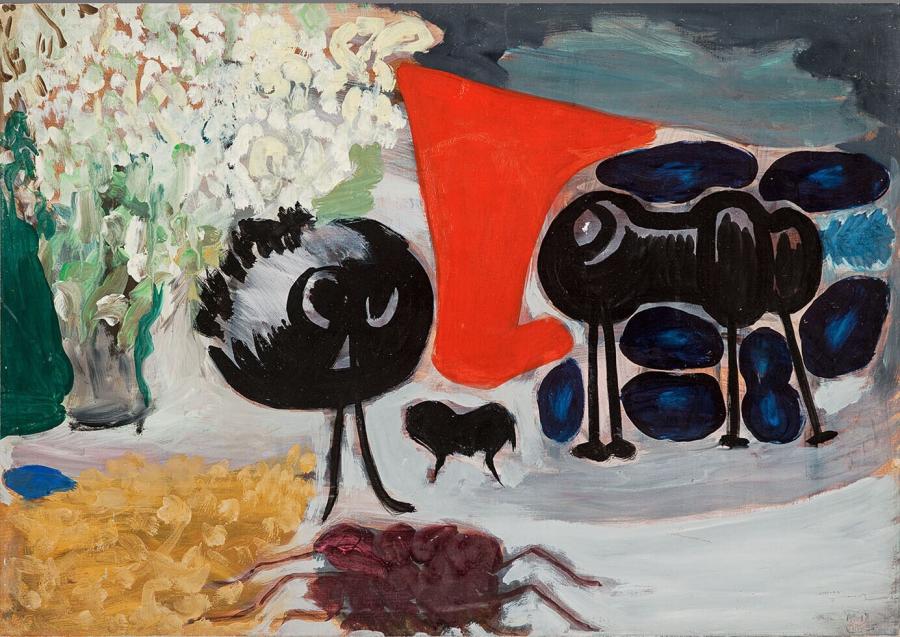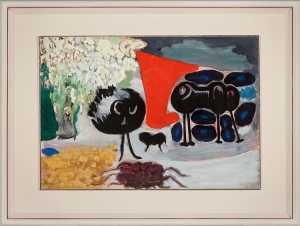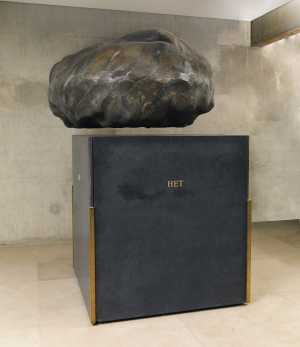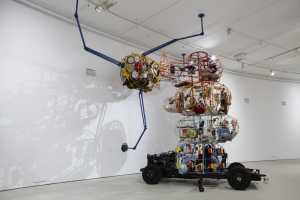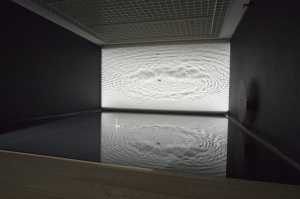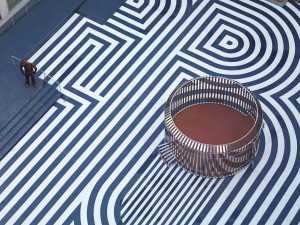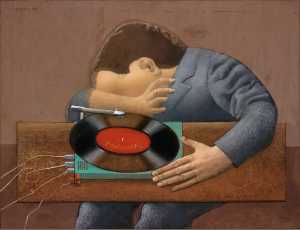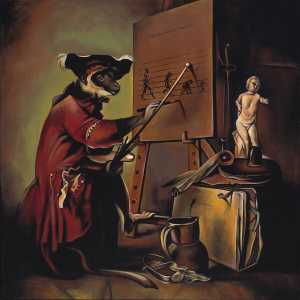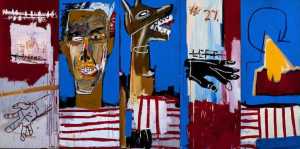Meret Oppenheim was a friend of many of the leading Surrealists, who loved her bizarre inventions. She is famous for the cup and saucer that she covered in fur and exhibited as ‘Breakfast in fur’. However, there was another very different side to her, as illustrated by this poetic little picture that she made in 1955 after years of absence from the art world.

Specifications
| Title | Sous les résédas |
|---|---|
| Material and technique | Oil on hardboard |
| Object type |
Painting
> Painting
> Two-dimensional object
> Art object
|
| Location | This object is in storage |
| Dimensions |
Height 48 cm Width 69 cm |
|---|---|
| Artists |
Artist:
Meret Oppenheim
|
| Accession number | 3623 (MK) |
| Credits | Purchased with the support of VriendenLoterij, 2010 |
| Department | Modern Art |
| Acquisition date | 2010 |
| Creation date | in 1955 |
| Provenance | Artist’s family; private collection Basel, Switzerland; Galerie Krinzinger, Vienna 2010 |
| Exhibitions | Vienna/Arnhem/Uppsala/Helsinki 1997-98; Rotterdam 2015a; Rotterdam 2017b |
| Internal exhibitions |
The Collection Enriched (2011) Collectie - surrealisme (2017) |
| External exhibitions |
Dalí, Magritte, Man Ray and Surrealism. Highlights from Museum Boijmans Van Beuningen (2023) A Surreal Shock – Masterpieces from Museum Boijmans Van Beuningen (2021) A Surreal Shock. Masterpieces from Museum Boijmans Van Beuningen (2023) Surrealist Art - Masterpieces from Museum Boijmans Van Beuningen (2021) Only the Marvelous is Beautiful (2022) |
| Research |
Show research A dream collection - Surrealism in Museum Boijmans Van Beuningen |
| Literature | Curiger 1989, p. 162; Arnhem/Uppsala/Helsinki 1997, p. 206, fig. VII |
| Material | |
| Object |
Entry catalogue A dream collection - Surrealism in Museum Boijmans Van Beuningen
Author: Marijke Peyser
In 1932 the Swiss artist Meret Oppenheim went to Paris to spend a short time taking a course at the Académie de la Grande Chaumière, an alternative to the more expensive Académie des Beaux-Arts. In Paris she met Alberto Giacometti and Jean (Hans) Arp and was soon admitted to Surrealist circles. Her work was shown in exhibitions in London and New York alongside that of Paul Klee, Pablo Picasso, Francis Picabia, Marcel Duchamp and Giorgio de Chirico.[1] Oppenheim’s great breakthrough came during the first exhibition devoted to Surrealist objects that André Breton staged at the Galerie Charles Ratton in Paris in 1936. The fur-covered cup and saucer she made for the occasion caused a sensation. Breton gave the object the title Déjeuner en fourrure, a reference to the well-known painting Déjeuner sur l’herbe (1862) by Édouard Manet, which caused a scandal because of the erotic implications of a naked woman having lunch in the company of two clothed gentlemen.[2] Immediately after the exhibition in Paris, Alfred H. Barr Jr, the first director of the Museum of Modern Art in New York, bought the object for his museum. Barr explained why the fur-covered cup and saucer appealed so much to the imagination: ‘Like Lautréamont’s illustrious words [see Illustrations for 'The Songs of Maldoror'], the tea set makes the most extreme, most bizarre improbability reality. The tension and excitement that emanate from this object have caused anger, joy, disgust or enjoyment in tens of thousands of Americans’.[3]
The painting Sous les résédas was made in 1955 when Oppenheim began to work again after she had withdrawn from the art world because of depression that lasted for decades. Although the image does not immediately appear to be Surrealist, the title does. It plainly refers to Les chants de Maldoror (1868-69), the Surrealist’s cult book, written by the Comte de Lautréamont (see Illustrations for 'The Songs of Maldoror'). In the first stanza of the second song the author says that he has unmasked man’s true nature: ‘He always believed – even though his eyelids yielded to the resedas of modesty – that he was composed only of good and minimal quantities of bad.’[4] On 12 April 1956, in response to the painting, Benjamin Péret wrote a poem of the same name and dedicated it to her.[5] Using metaphors, Péret described the ever-present talent of the artist and the ‘rebirth’ from her artistic crisis. He called on his readers to look at the reseda plant and to discover that a strong yet at the same time light breeze stirred the plant: ‘Meret controls its speed and force / Nothing stands in the way of the growth of the plant / A hesitant golden glow appears that is greeted by the first, as yet invisible, bird. That bird is Meret.’[6]
In 1977 Renilde Hammacher-Van den Brande, curator of modern art at Museum Boijmans Van Beuningen, wrote to Oppenheim. She saw the lack of a work by Oppenheim as a great deficiency in the Surrealism collection and hoped that the new director would be able to raise some money to purchase one.[7] However it was not until 2010 that Museum Boijmans Van Beuningen was able to acquire Sous les résédas.
Footnotes
[1] New York/Chicago/Miami Beach/Omaha 1996-97. pp. 24-25.
[2] Vienna/Berlin 2013, p. 17.
[3] Barr 1937, p. 4.
[4] See Nesselroth 1969, p. 103.
[5] Péret was one of the mainstays of the Surrealist movement and throughout the years a loyal disciple of André Breton. There is a copy of the poem with the date of the dedication in the MBVB Archives, Meret Oppenheim object file, Sous les résédas.
[6] Ibid.
[7] Ibid., letter from Hammacher-Van den Brande to Oppenheim, 27 December 1977.






